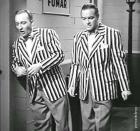“Well, nobody’s perfect!”
It takes a certain amount of bravery to be an actor. Since the recent decline of the world of cinema, that statement doesn’t have as much truth as it once did. However, this week I’m recommending a film with two of the bravest actors I’ve ever seen.
Although director/cowriter Billy Wilder had considered such comedy legends as Bob Hope, Danny Kaye, and Jerry Lewis, he finally settled on the pairing of Tony Curtis and Jack Lemmon. This, as is evidenced by the film’s legendary status, was ultimately a good choice.
Most of the time, people do not voluntarily ask me questions concerning classic film. This is because they are aware of the onslaught of useless information which will inevitably follow such a question. However, I’m going to make a hypothetical scenario here: If someone were to ask me what the definition of screwball comedy is, I’d reply quite simply, “Look no further than Some Like It Hot.”
And, similarly, I’ll say to you, “If you’re in the mood for a good laugh, a movie with no deep probing into the mysteries of the afterlife, no overt political themes, no animated animal sidekicks, and certainly no metaphorical chess games with the grim reaper, this is the movie for you.”
Many reviews of this film sound as though they were written by psychiatrists. Don’t be put off by these ambiguous reviews. Listen to good ol’ Uncle Luke. I won’t try to say that Curtis and Lemmon dressed as women because they had a bad home life. I’ll simply say that they dressed up as women because it’s funny. I don’t mean to rant, but I hate it when reviewers make a plain-and-simple screwball comedy sound like a philosophical exploration of id and psyche. Give. Me. A. Break.
*sigh* Sorry.
Anyway, it’s a hilarious, ahead-of-its-time comedy masterpiece. Bon appetit!
Synopsis
After accidentally witnessing the St. Valentine’s Day Massacre, struggling musicians Joe (Tony Curtis) and Jerry (Jack Lemmon) find themselves on the run. In a last-minute attempt to escape from Chicago, Joe and Jerry don feminine getups and join a Florida-bound all-girl jazz band. Once at the hotel, Joe falls for fellow band member Sugar Kane (Marilyn Monroe), and he tries to maintain a double-life: the fictional millionaire beau of Sugar’s dreams, and Josephine, Sugar’s female friend. Meanwhile, Jerry (“Daphne”) has a rich suitor (Joe E. Brown) who won’t take “No” for an answer.
Then, of course, the Chicago mob arrives at the hotel.
Information
Directed by Billy Wilder;
Written by Robert Thoeren (story on which it was based), Michael Logan (story on which it was based), Billy Wilder (screenplay), I.A.L. Diamond (screenplay);
Starring Tony Curtis as Joe – “Josephine”, Jack Lemmon as Jerry – “Daphne”, Marilyn Monroe as Sugar Kane Kowalczyk, Joe E. Brown as Osgood Fielding III, George Raft as Spats Colombo, and Pat O’Brien as Detective Mulligan;
Produced by Billy Wilder (producer), I.A.L. Diamond (associate producer), and Doane Harrison (associate producer);
Music by Adolph Deutsch.
Facts
Bob Hope, Danny Kaye, Jerry Lewis, and Frank Sinatra were considered for the roles of Joe and Jerry.
It took 47 takes for Marilyn Monroe to get the line, “It’s me, Sugar,” right. After the 30th take, Wilder wrote the line on a blackboard. Another line, “Where’s the bourbon?”, required 59 takes. (I respect Billy Wilder for his patience. Personally, I would’ve killed someone by then.)
A preview audience laughed so hard in the scene where Jack Lemmon announces his engagement that a lot of the dialogue was missed. It had to be re-shot with pauses (and the maraca gimmick) added.
There’s been plenty of talk about Monroe’s behavior. Billy Wilder even said, “We were in mid-flight, and there was a nut on the plane,” when referring to Monroe. Indeed, Wilder publicly blasted Monroe for her behavior, and she was not invited to the wrap party.
Anthony Perkins (best known for the character Norman Bates in Hitchcock’s Psycho) auditioned for the role of Jerry.
Upon its original release, Kansas banned the film from being shown in the state, explaining that cross-dressing was “too disturbing for Kansans”.
In Russia, the film is titled “Only Girls Are Allowed In Jazz”. Hmm…
This, like most films by ’59 (for instance, Ben-Hur, Rio Bravo, and Sleeping Beauty) were filmed in color. However, Wilder filmed Some Like It Hot in black & white because Curtis’ and Lemmon’s makeup gave their faces a greenish tinge.
Some Like It Hot was voted #1 on the American Film Institute’s List of 100 Funniest Movies, and #14 on their List of 100 Greatest Movies.
-luke



